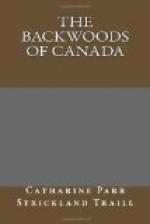The fire-flies must not be forgotten, for of all others they are the most remarkable; their appearance generally precedes rain; they are often seen after dark, on mild damp evenings, sporting among the cedars at the edge of the wood, and especially near swamps, when the air is illuminated with their brilliant dancing light. Sometimes they may be seen in groups, glancing like falling stars in mid-air, or descending so low as to enter your dwelling and flit about among the draperies of your bed or window curtains; the light they emit is more brilliant than that of the glowworm; but it is produced in the same manner from the under part of the body. The glowworm is also frequently seen, even as late as September, on mild, warm, dewy nights.
We have abundance of large and small beetles, some most splendid: green and gold, rose-colour, red and black, yellow and black; some quite black, formidably large, with wide branching horns. Wasps are not so troublesome as in England, but I suppose it is because we cannot offer such temptations as our home gardens hold out to these ravenous insects.
One of our choppers brought me the other day what he called a hornet’s nest; it was certainly too small and delicate a piece of workmanship for so large an insect; and I rather conjecture that it belonged to the beautiful black and gold insect called the wasp-fly, but of this I am not certain. The nest was about the size and shape of a turkey’s egg, and was composed of six paper cups inserted one within the other, each lessening till the innermost of all appeared not larger than a pigeon’s egg. On looking carefully within the orifice of the last cup, a small comb, containing twelve cells, of the most exquisite neatness, might be perceived, if anything, superior in regularity to the cells in the comb of the domestic bee, one of which was at least equal to three of these. The substance that composed the cups was of a fine silver grey silken texture, as fine as the finest India silk paper, and extremely brittle; when slightly wetted it became glutinous, and adhered a little to the finger; the whole was carefully fixed to a stick: I have seen one since fastened to a rough rail. I could not but admire the instinctive care displayed in the formation of this exquisite piece of insect architecture to guard the embryo animal from injury, either from the voracity of birds or the effect of rain, which could scarcely find entrance in the interior.
I had carefully, as I thought, preserved my treasure, by putting it in one of my drawers, but a wicked little thief of a mouse found it out and tore it to pieces for the sake of the drops of honey contained in one or two of the cells. I was much vexed, as I purposed sending it by some favourable opportunity to a dear friend living in Gloucester Place, who took great delight in natural curiosities, and once showed me a nest of similar form to this, that had been found in a bee-hive; the material was much coarser, and, if I remember right, had but two cases instead of six.




